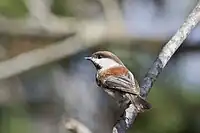
_(20325091656).jpg.webp)
The chickadees are a group of North American birds in the family Paridae included in the genus Poecile. Species found in North America are referred to as chickadees; species found elsewhere in the world are called tits.[1][2] They are small-sized birds overall, usually having the crown of the head and throat patch distinctly darker than the body. They are at least 6 to 14 centimeters (2.4 to 5.5 inches) in size.
Their name reputedly comes from the fact that their calls make a distinctive "chick-a-dee-dee-dee",[3] though their normal call is actually "fee-bee," and the "chick-a-dee-dee-dee" call is an alarm call. The number of "dees" depends on the predator.[4]
The chickadee (specifically the black-capped chickadee Poecile atricapillus, formerly Parus atricapillus) is the official bird for the US states of Massachusetts and Maine,[5][6][7] the Canadian province of New Brunswick,[8] and the city of Calgary, Alberta.[9]
One holarctic species is referred to by a different name in each part of its range: grey-headed chickadee in North America and Siberian tit in Eurasia.
Habitat
Chickadees are native to North America, where they are very common. In North America, the birds are found from the East Coast to the West Coast, and from Canada to Mexico. The habitat that chickadees prefer is mixed deciduous or coniferous forests, parks, open woods, cottonwood groves, willow thickets, and disturbed areas.[10]
Memory
Mountain chickadees are food-caching birds. A single bird can hide as many as 80,000 individual seeds, which they retrieve during the winter. Their ability to do so depends on their spatial memory of the locations. Birds that live in harsher conditions, where their ability to remember the location of food is more important, have been found to have better memory abilities, a larger hippocampus, and more neurons than chickadees that live in milder climates where food sources are easier to find without relying on memory.[11][12]
Species
- Black-capped chickadee (Poecile atricapillus)
- Boreal chickadee (Poecile hudsonicus)
- Carolina chickadee (Poecile carolinensis)
- Chestnut-backed chickadee (Poecile rufescens)
- Grey-headed chickadee (Poecile cinctus)
- Mexican chickadee (Poecile sclateri)
- Mountain chickadee (Poecile gambeli)
References
- ↑ Heisman, Rebecca (January 4, 2022). "Beloved Backyard Bandits: An Introduction to Chickadees". American Bird Conservancy. Retrieved March 27, 2023.
- ↑ "Tit". Merriam-Webster. Retrieved March 27, 2023.
- ↑ The Merriam-Webster New Book of Word Histories. Springfield, MA, USA: Merriam-Webster. 1991. p. 362. ISBN 0-87779-603-3.
- ↑ "Chirpy chickadees signal deadliness of predators". New Scientist. 23 June 2005. Retrieved 6 March 2019.
- ↑ Massachusetts Facts Secretary of the Commonwealth. Retrieved 6 March 2019.
- ↑ The problem with naming ‘the chickadee’ as Maine’s state bird Bangor Daily News. 28 February 2019. Retrieved 6 March 2019.
- ↑ "State Bird - Chickadee". Maine Secretary of State. Retrieved 27 August 2018.
- ↑ Government of New Brunswick, Canada (2020-06-17). "NB Symbols". www2.gnb.ca. Retrieved 2022-08-17.
- ↑ Villani, Mark. "Tweet it out! Calgary names official bird". ctvnews. Retrieved 2022-05-18.
- ↑ "Chickadee: Description, Pictures, & Fun Facts I TheBirdPedia". 2021-12-15. Retrieved 2022-02-10.
- ↑ Mason, Betsy (5 September 2019). "Total recall: A brilliant memory helps chickadees survive". Knowable Magazine. doi:10.1146/knowable-090519-1. Retrieved 24 February 2022.
- ↑ Pravosudov, Vladimir V.; Roth II, Timothy C. (23 November 2013). "Cognitive Ecology of Food Hoarding: The Evolution of Spatial Memory and the Hippocampus". Annual Review of Ecology, Evolution, and Systematics. 44 (1): 173–193. doi:10.1146/annurev-ecolsys-110512-135904. ISSN 1543-592X. Retrieved 24 February 2022.